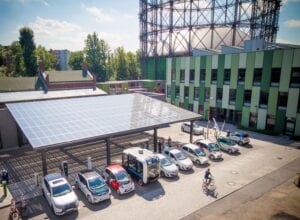When owners of commercial and industrial buildings experience unplanned power outages, the effects are immediate: loss of production and/or services, high restart costs, and, in the case of industrial sites, reduced operational equipment efficiency. In fact, the ability to maintain resilient commercial and industrial operations has emerged as a critical success factor as increased levels of systems connectivity make supply chains more susceptible to potential cascading disruptions. The resilience of core infrastructure lynchpins such as stable electrical power often determines how market share is won and lost. For these reasons, an increasing number of businesses and municipalities are considering microgrids.
Unfortunately, over the last several years, extreme weather events have added to the level of power-related anxiety. In the United States, for example, California wildfires, unusually cold temperatures in Texas, and high winds across Iowa and Wisconsin have contributed to the sense of uncertainty when it comes to traditional utility power supply dependence. But inclement weather is not the only threat to the power supply. Bad actors intent on pursuing cyberattacks on electrical utilities and an aging grid infrastructure (such as spent transformers that fail) also represent real threats to the integrity of the current utility power systems.

We at AZZO, a Schneider Electric Master-level Critical Power EcoXpert, witness many of these power outage-related business continuity issues in the field. Among our customers, we see a growing realization that sustainability and resilience are tied together. In addition to plants and commercial enterprises, police stations, firehouses, office buildings, hospitals, and schools all require reliable power. Microgrids are no longer only for large corporate entities.
How microgrids add value
Many commercial and industrial business stakeholders recognize that having electrical generation facilities much closer to the site of the consuming loads is now more affordable, flexible, and sustainable. Over the last several years, the price of deploying solar power facilities has dropped dramatically as has the price of energy storage. Microgrid automation systems have also become much more sophisticated and can work in tandem with traditional grids as a clean source of backup power (as opposed to noisy diesel and gas generators that rely on fossil fuels).
Today, there are multiple reasons for organizations and municipalities to consider microgrids as a source for driving greater resilience. Below are several examples.
Microgrids lower carbon footprint
Our partner, Schneider Electric, through AlphaStruxure, its joint venture with Carlyle Global Infrastructure Opportunity Fund, acts as a provider of Energy-as-a-Service (EaaS) solutions. AlphaStruxure recently announced an agreement to deploy an integrated microgrid and electric bus charging infrastructure for a large municipality in the state of Maryland. The municipality decided to roll out a fleet of electric buses as a principal means of public transportation. Their electric bus depot microgrid project is a great example of how microgrid technology can support energy-intensive environments. These buses represent a substantial electrical load, and a reliable power supply is needed because the buses are essential for moving people around the county metro area. The project will enable at least 44 buses to transition from diesel to electric, advancing the county’s sustainability goals and reducing lifetime emissions by more than 155,000 tons.
Microgrids help revenue generation and reduce energy costs
An Australian customer of ours, South Australian Produce Market (SAPM), uses its microgrid to both protect the livelihoods of its affiliate farmers and to reduce its overall energy bill. SAPM runs an enormous refrigerated warehouse facility that stores much of the farmers’ produce (click here to see the video). Prior to the implementation of the microgrid, a state wide power outage in South Australia led to significant lost revenues due to vegetable spoilage as the refrigerated warehouse could no longer cool the vegetables. This scenario was the main reason why SAPM opted for a microgrid.
SAPM also uses solar energy to power their refrigerated warehouse facility and uses batteries to store the extra energy they produce. Their microgrid is managed by a Schneider Electric tool, EcoStruxure Microgrid Advisor which is a cloud-based microgrid optimization software that helps them make the decisions on how best to manage pricing, demand, and load profiles, based on several factors including weather conditions.
As the microgrid helps to manage both the energy generation and storage, SAPM can both shave their utility peak demand charges and also sell their excess capacity back to the utility. As a result, SAPM’s microgrid has become a revenue-generating asset as well as a lower-cost solution for consuming power. If such a system were deployed in microgrids across the state of Texas, when they experience a long-term power outage in February of 2021, these microgrids could have sold energy back to the grid operators at the premium (at the time the utility’s “buy” price topped out at $9,000 per mW hour).
The SAPM project recently received the prestigious Microgrid for the Greater Good Award at the Microgrid Knowledge virtual conference.
Microgrids improve reliability
A utility in a midwestern state is now beginning to provide its customers with “resiliency as a service” by placing microgrids at some of their key customers’ sites to ensure power supply reliability. Not only does this help address the needs of customers with critical power requirements, but it also serves as an acknowledgment that some utility grids need assistance in supporting non-traditional renewable energy generation applications.
For more information about microgrids
When power-intensive situations call for an extra measure of reliability and resilience, microgrids can play an important role in minimizing risks. The combination of solar power, energy storage, and microgrid control software ensures that business owners and municipalities achieve the most from the energy their infrastructure assets consume. To learn how to avoid unnecessary power outage-related costs and risks, access the Schneider Electric web pages.
 |
Schneider Electric has been recognized as the world’s most sustainable corporation in 2021 by Corporate Knights Global 100 Index. |
EcoXperts are the Enablers of Buildings of the Future
The EcoXpert Partner Program is unique in its industry and made up of a best-in-class global ecosystem of expertise. Trained and certified by Schneider Electric, EcoXperts are the implementation arms of EcoStruxure and Wiser all over the world.
Buildings of the Future is about delivering solutions for the sustainable, resilient, hyper-efficient, and people-centric buildings that our customers need. For our EcoXpert partners, this unveils immense growth opportunity through the transition to end-to-end portfolio sales that will resolve our customers’ most critical needs. For our shared customers, this means that together with our EcoXpert partners, we will drive the building industry transformation and help our customers survive and thrive today – and tomorrow.
Visit EcoXpert to learn more. Discover Buildings of the Future.



